Large denominations of United States currency
US currency larger than $100 From Wikipedia, the free encyclopedia
Large denominations of United States currency greater than $100 were circulated by the United States Treasury until 1969. Since then, U.S. dollar banknotes have been issued in seven denominations: $1, $2, $5, $10, $20, $50, and $100.
Overview and history
Large-denomination currency (i.e., banknotes with a face value of $500 or higher)[1] had been used in the United States since the late 18th century.[2] The first $500 note was issued by North Carolina, authorized by legislation dated May 10, 1780.[3] Virginia quickly followed suit and authorized the printing of $500 and $1,000 notes on October 16, 1780,[4] and $2,000 notes on May 7, 1781.[5] High-denomination treasury notes were issued; for example, during the War of 1812 ($1,000 notes authorized by an act dated June 30, 1812).[6] During the American Civil War, Confederate currency included $500 and $1,000 notes.[7] The earliest (1861) federal banknotes included high-denomination notes such as three-year interest-bearing notes of $500, $1,000, and $5,000, authorized by Congress on July 17, 1861.[8] In total, 11 different types of U.S. currency were issued in high-denomination notes across nearly 20 different series dates. The obverse designs of United States banknotes generally depict either historical figures, allegorical figures symbolizing significant concepts (e.g., liberty, justice), or both. The reverse designs range from abstract scroll-work with ornate denomination identifiers to reproductions of historical art works.
Public versus institutional use
Series 1934 gold certificates ($100; $500; $1,000; $10,000; and $100,000) were issued after the gold standard was repealed and gold was compulsorily confiscated by order of President Franklin Roosevelt on March 9, 1933 (see United States Executive Order 6102). Thus, the series 1934 notes were used only for intragovernmental (i.e., Federal Reserve Bank) transactions and were not issued to the public.[9] This series was discontinued in 1940. The series 1928 gold certificate reverse was printed in black and green (see History of the United States dollar).
Passive retirement
Summarize
Perspective
Although they remain legal tender in the United States, high-denomination bills were last printed on December 27, 1945, and were officially discontinued on July 14, 1969, by the Federal Reserve System[10] because of "lack of use".[11] The lower production $5,000 and $10,000 notes had effectively disappeared well before then.[nb 1]
Beginning in July 1969, the Federal Reserve began removing high-denomination currency from circulation and destroying any large bills returned by banks.[11] As of May 30, 2009[update], only 336 $10,000 bills were known to exist, along with 342 $5,000 bills, 165,372 $1,000 bills and fewer than 75,000 $500 bills (of over 900,000 printed).[12][13] Due to their rarity, collectors pay considerably more than the face value of the bills to acquire them, and some are in museums in other parts of the world.
These larger denomination bills were mainly used by banks and the federal government for large financial transactions, which was especially true for gold certificates from 1865 to 1934. Given that the introduction of electronic money systems has made large-scale cash transactions mostly obsolete, as well as concerns about counterfeiting and the use of cash for unlawful activities (such as drug trafficking and money laundering), it is unlikely that the U.S. government will reissue any large-denomination currency in the foreseeable future.[citation needed]
According to the U.S. Department of Treasury website, "The present denominations of our currency in production are $1, $2, $5, $10, $20, $50 and $100. The purpose of the United States currency system is to serve the needs of the public and these denominations meet that goal. Neither the Department of the Treasury nor the Federal Reserve System has any plans to change the denominations in use today."[14]
High-denomination banknote issuing data
| Abbr | Type | Size[nb 3] | Series dates | High denomination series date | Comments | ||||
|---|---|---|---|---|---|---|---|---|---|
| $500 | $1,000 | $5,000 | $10,000 | $100,000 | |||||
| LT | Legal tender | Large | 1862–1923 | 1862 1863 1869 1874 1875 1878 1880 |
1862 1863 1869 1878 1880 |
1878 | 1878 | – | [nb 4] |
| CITN | Compound interest treasury note | Exception | 1863–1864 | 1863 1864 |
1864 | – | – | – | |
| IBN | Interest bearing note | Exception | 1861–1865 | 1861 1863 1864 1865 |
1861 1863 1864 1865 |
1861 1863 1864 1865 |
– | – | [nb 5] |
| SC | Silver certificate | Large | 1878–1923 | 1878 1880 |
1878 1880 1891 |
– | – | – | |
| TN | Treasury note | Large | 1890–1891 | 1891[nb 6] | 1890 1891 |
– | – | – | |
| NBN | National bank note | Large | 1865–1875 | 1865 1875 |
1865 1875 |
– | – | – | |
| FRN | Federal reserve note | Large | 1914–1918 | 1918 | 1918 | 1918 | 1918 | – | |
| NGBN | National gold bank note | Large | 1870–1883 | 1870[nb 7] | –[nb 8] | – | – | – | [nb 9] |
| GC | Gold certificate | Large[nb 10] | 1865–1922 | 1865 1870 1875 1882 1922 |
1865 1870 1875 1882 1907 1922 |
1865 1870 1882 1888 |
1865 1870 1875 1882 1888 1900 |
– | |
| FRN | Federal reserve note | Small | 1928–present | 1928 1934 |
1928 1934 |
1928 1934 |
1928 1934 |
– | |
| GC | Gold certificate | Small | 1928–1934[nb 11] | 1928 | 1928 1934 |
1928 | 1928 1934 |
1934 | |
Table of banknotes
Summarize
Perspective
The National Numismatic Collection at the Smithsonian Institution contains the Bureau of Engraving and Printing (BEP) certified proofs and the Treasury Department collection of United States currency. Using a combination of proofs and issued notes, a nearly complete type set of high-denomination currency was compiled. Notably missing are several types of Compound and Interest Bearing Notes. Printed during the early to mid-1860s on very thin paper, these high-denomination notes are virtually non-existent. Their issuance (1861–65) predates the BEP's responsibility for U.S. currency (1870s), so it is fortunate that any proofs exist in the current archives.
| Value | Type | Series | Friedberg number | Image | Portrait/engraving[nb 13] | Comments[nb 14] |
|---|---|---|---|---|---|---|
| $500 | LT | 1862–1863 | Fr.183c | 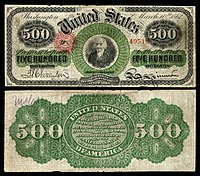 |
Albert Gallatin | 4 known (variety) 7 known (type)[21] |
| $500 | LT | 1869 | Fr.184 | 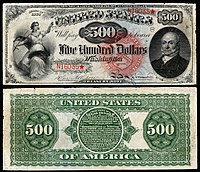 |
John Quincy Adams (Charles Burt)[22] Justice (Stephen A. Schoff)[23] |
4 known (only one privately)[24] |
| $500 | LT | 1874–1878 | Fr.185b | 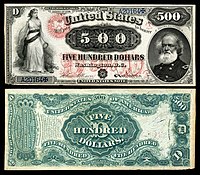 |
Joseph Mansfield (Charles Burt)[22] Victory (Charles Burt)[25] |
|
| $500 | LT | 1880 | Fr.185l |  |
Joseph Mansfield (Charles Burt)[22] Victory (Charles Burt)[25] |
5 known (variety)[nb 15] |
| $500 | CITN | 1864 | Fr.194a Proof |
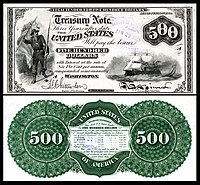 |
Standard Bearer (left) (George D. Baldwin)[27] New Ironsides (right) (James Smillie)[28] |
Unknown[29] |
| $500 | SC | 1878 | Fr.345a | 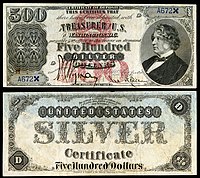 |
Charles Sumner (Charles Burt)[22] |
Unique (variety and type)[30] |
| $500 | SC | 1880 | Fr.345c |  |
Charles Sumner (Charles Burt)[22] |
5 known (variety) 7 known (type)[30] |
| $500 | TN | 1891 | Fr.379 Proof |
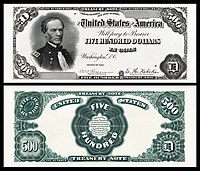 |
William Tecumseh Sherman | None issued[31] |
| $500 | NBN | 1865–1875 | Fr.464 |  |
Civilization (left) (James D. Smillie)[32] Sirius arriving in New York (right) Surrender of General Burgoyne (rev) (Frederick Girsch)[33] |
2 known (variety) 3 known (type)[34] |
| $500 | FRN | 1918 | Fr.1132d |  |
John Marshall (Charles Schlecht)[35] de Soto discovering the Mississippi (rev) (Frederick Girsch)[33] |
|
| $500 | GC | 1863 | Fr.1166d Proof |
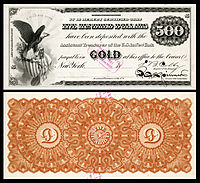 |
Eagle with shield or E Pluribus Unum (Charles Skinner)[36] |
Unknown[37] |
| $500 | GC | 1870–1875 | Fr.1166i |  |
Abraham Lincoln (Charles Burt)[22] |
Unique[37] |
| $500 | GC | 1882–1922 | Fr.1216a | 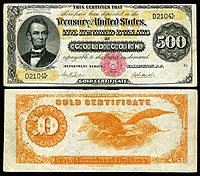 |
Abraham Lincoln (Charles Burt)[22] |
|
| $500 | FRN | 1928–1934 | Fr.2200g |  |
William McKinley (John Eissler)[38] |
|
| $500 | GC | 1928 | Fr.2407 | 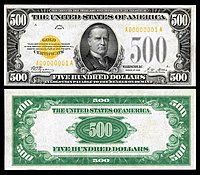 |
William McKinley (John Eissler)[38] |
|
| $1,000 | LT | 1862–1863 | Fr.186e |  |
Robert Morris (Charles Schlecht)[35] |
Unique (variety) 5 known (type)[39] |
| $1,000 | LT | 1869 | Fr.186f Proof |
DeWitt Clinton | 2 known[40] | |
| $1,000 | LT | 1878 | Fr.187a | 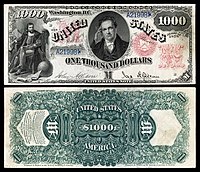 |
DeWitt Clinton Columbus in his study (Henry Gugler)[41] |
|
| $1,000 | LT | 1880 | Fr.187k | 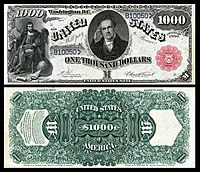 |
DeWitt Clinton Columbus in his study (Henry Gugler)[41] |
4 known (variety) ~20–25 known (type)[nb 16] |
| $1,000 | IBN | 1863 | Fr.201 Proof |
 |
Justice (left); Liberty (right) | Unknown[42] |
| $1,000 | IBN | 1863 | Fr.206 Proof |
 |
Guerriere and the Constitution (left) and Discovery of the Mississippi by De Soto (right) | Unknown[43] |
| $1,000 | SC | 1878 | Fr.346a Proof |
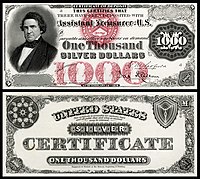 |
William Marcy (Charles Schlecht)[35] |
Unknown[44] |
| $1,000 | SC | 1880 | Fr.346d | 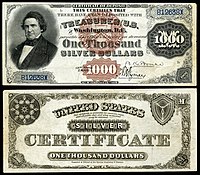 |
William Marcy (Charles Schlecht)[35] |
5 known (variety) 5 known (type)[44] |
| $1,000 | SC | 1891 | Fr.346e | 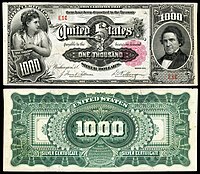 |
William Marcy (Charles Schlecht)[35] Liberty (Charles Burt)[45] |
2 known[44] |
| $1,000 | TN | 1890 | Fr.379a | 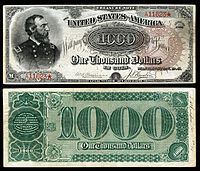 |
George Meade (Charles Burt)[22] |
5 known (variety) 7 known (type)[46] |
| $1,000 | TN | 1891 | Fr.379c |  |
George Meade (Charles Burt)[22] |
2 known (variety) 3 known (type)[46] |
| $1,000 | NBN | 1865–1875 | Fr.465 Proof |
 |
Scott entering City of Mexico (left) (Alfred Jones)[47] United States Capitol (right) (James Smillie)[28] Washington resigning his commission (rev) (Frederick Girsch)[33] |
Unknown[48] |
| $1,000 | FRN | 1918 | Fr.1133d |  |
Alexander Hamilton (G.F.C. Smillie)[49] Eagle (rev) (Marcus W. Baldwin)[50] |
|
| $1,000 | GC | 1863 | Fr.1166e Proof |
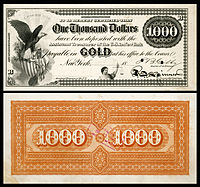 |
Eagle with shield or E Pluribus Unum (Charles Skinner)[36] Justice with scales |
Unique[37] |
| $1,000 | GC | 1870–1875 | Fr.1166o Proof |
 |
Alexander Hamilton (Charles Burt)[51] |
Unique[37] |
| $1,000 | GC | 1882 | Fr.1218g |  |
Alexander Hamilton (G.F.C. Smillie)[49] |
|
| $1,000 | GC | 1907–1922 | Fr.1219 |  |
Alexander Hamilton | |
| $1,000 | FRN | 1928–1934 | Fr.2210g | 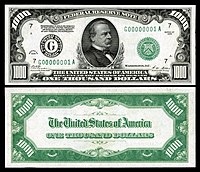 |
Grover Cleveland (John Eissler)[38] |
|
| $1,000 | GC | 1928 | Fr.2408 | 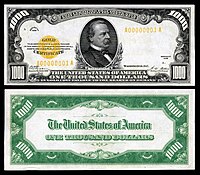 |
Grover Cleveland (John Eissler)[38] |
|
| $1,000 | GC | 1934 | Fr.2409 |  |
Grover Cleveland (John Eissler)[38] |
|
| $5,000 | LT | 1878 | Fr.188 Proof |
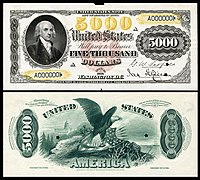 |
James Madison (Alfred Sealey)[52] Eagle (William Chorlton)[53] |
All notes have been redeemed, none outstanding[17] |
| $5,000 | IBN | 1863 | Fr.202 Proof |
 |
The Altar of Liberty (Louis Delnoce)[54] |
Unknown[42] |
| $5,000 | IBN | 1865 | Fr.212h Proof |
 |
Justice (left) New Ironsides (center) (James Smillie)[28] |
|
| $5,000 | FRN | 1918 | Fr.1134d | 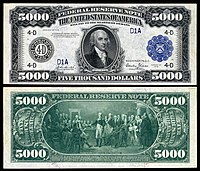 |
James Madison (Alfred Sealey)[55] Washington resigning his commission (rev) (Louis Delnoce)[54] |
Unique (variety) 5 known (type)[nb 17] |
| $5,000 | GC | 1863 | Fr.1166f Proof |
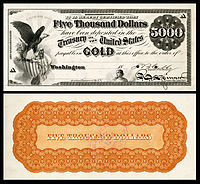 |
Eagle with shield or E Pluribus Unum (Charles Skinner)[36] Female |
Unique[37] |
| $5,000 | GC | 1870–1875 | Fr.1166k Proof |
 |
James Madison (Alfred Sealey)[51] |
Unknown[37] |
| $5,000 | GC | 1882 | Fr.1221a Proof |
 |
James Madison (Alfred Sealey)[57] |
Two known[37] |
| $5,000 | FRN | 1928–1934 | Fr.2220g |  |
James Madison (Alfred Sealey)[57] |
|
| $5,000 | GC | 1928 | Fr.2410 |  |
James Madison | |
| $10,000 | LT | 1878 | Fr.189 Proof |
 |
Andrew Jackson (Alfred Sealey)[58] |
All notes have been redeemed, none outstanding[17] |
| $10,000 | FRN | 1918 | Fr.1135d | 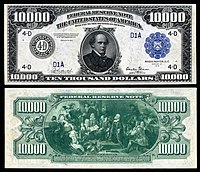 |
Salmon Chase; Embarkation of the Pilgrims (rev) | Unique (variety) 5 known (type)[nb 18] |
| $10,000 | GC | 1863 | Fr.1166g Proof |
 |
Eagle with shield or E Pluribus Unum (Charles Skinner)[36] |
Unknown[37] |
| $10,000 | GC | 1870–1875 | Fr.1166l Proof |
 |
Andrew Jackson | Unique[37] |
| $10,000 | GC | 1882 | Fr.1223a Proof |
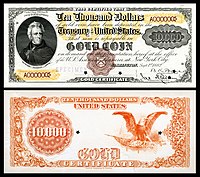 |
Andrew Jackson (Alfred Sealey)[57] |
Two known[37] |
| $10,000 | GC | 1900 | Fr.1225 | 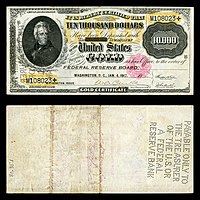 |
Andrew Jackson (Alfred Sealey)[57] |
|
| $10,000 | FRN | 1928–1934 | Fr.2230b |  |
Salmon P. Chase | |
| $10,000 | GC | 1928 | Fr.2411 | 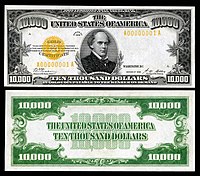 |
Salmon P. Chase | |
| $10,000 | GC | 1934 | Fr.2412 |  |
Salmon P. Chase | |
| $100,000 | GC | 1934 | Fr.2413 |  |
Woodrow Wilson (G.F.C. Smillie)[49] Reverse (Frederick Pauling)[59] |
Was never in circulation; cannot legally be privately held |
See also
References
External links
Wikiwand - on
Seamless Wikipedia browsing. On steroids.